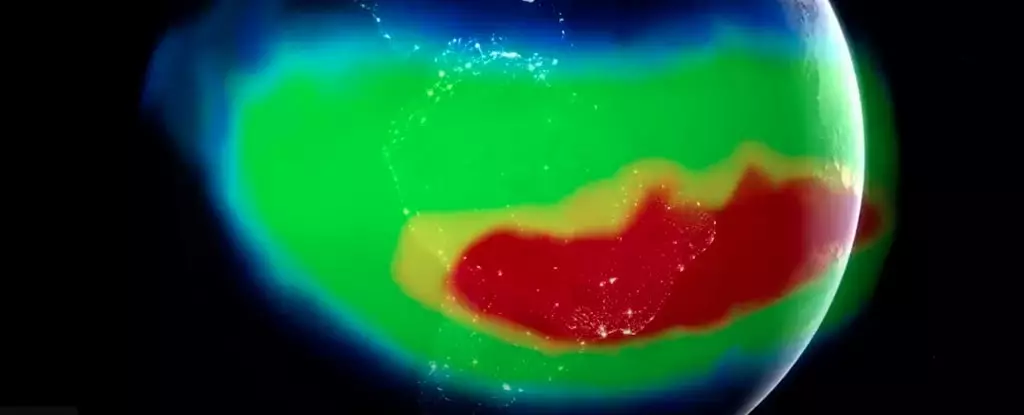In the vast expanse above our planet, an intriguing enigma known as the South Atlantic Anomaly (SAA) has captivated scientists, particularly those at NASA. This peculiar region, characterized by lower magnetic intensity, stretches between South America and southwest Africa, forming a ‘dent’ in Earth’s magnetic field. While the anomaly itself poses minimal threat to life on Earth, its implications for satellites and orbital spacecraft are far more concerning. The weak magnetic field in this area exposes these high-tech machines to torrents of charged particles emitted by the Sun, complicating our quest for a more profound understanding of the universe and our position within it.
The SAA represents a remarkable intersection of natural phenomena and technological vulnerability. For NASA and other space agencies, acknowledging this void in magnetic protection is not just about safeguarding their assets; it’s about unraveling the mysteries tied to Earth’s magnetic field. Interestingly, the SAA reveals unexpected complexities that underline our planet’s internal dynamics.
A Magnetically Unstable Region
NASA’s geophysicists have drawn fascinating parallels between the SAA and various geological and astrophysical processes. The prevailing theory suggests that the SAA’s weakened magnetic field is influenced by a vast reservoir of dense rock resting deep beneath the African continent, around 2,900 kilometers (1,800 miles) below the surface. This geological formation, known as the African Large Low Shear Velocity Province, disturbs the dynamics of Earth’s magnetic field generation. The cooling and solidifying outer shell of our planet and the molten iron swirling within its core generate the electromagnetic forces shaping our magnetic field. Herein lies the crux of the SAA’s significance: it is a telltale sign of our complex and turbulent geological past.
A 2020 revelation by NASA entailed that changes within this area could lead to a decline in the dipole magnetic field influence, suggesting an evolution of magnetic behavior in this region. Weijia Kuang, a prominent geophysicist, indicated that an emerging field with reversed polarity is contributing to the anomaly’s unique characteristics. Understanding what drives these changes might offer insights into the long-term stability and behavior of Earth’s magnetic field, a crucial topic given its role in shielding our planet from solar and cosmic radiation.
The Evolution of the Anomaly
As scientists delve deeper into the dynamics of the SAA, new revelations emerge continuously. Notably, the SAA appears to be drifting. Tracking conducted via CubeSats has offered a glimpse into its movement patterns, confirming findings from earlier studies. However, the most shocking revelation is the prospect of the SAA splitting into two separate regions of magnetic weakness—a phenomenon observed as early as 2020. Each emerging center signifies a new epicenter of minimal magnetic intensity, raising numerous questions about what this fragmentation means for Earth’s magnetic environment.
Critically, some researchers speculate that the SAA is not simply an anomaly of recent origin but rather a recurring event in Earth’s magnetic history, potentially dating back as far as 11 million years. If substantiated, this perspective challenges conventional narratives relating to magnetic field reversals, which lead many to fear chaos on a global scale. Rather than signaling an impending flip of Earth’s magnetic poles, the existence of the SAA might suggest that similar anomalies have come and gone throughout our planet’s timeline.
Challenges for Space Technology
For operatives of satellite technology, the implications of the SAA are urgent. Each time a spacecraft traverses this magnetic pocket, it faces potential operational disruptions—scientific instruments can suffer malfunctions from high-energy protons, and the systems onboard can short-circuit. In this charged environment, satellite operators must navigate the precarious balance between data collection and technological vulnerability, often opting to disable certain systems as a precautionary measure.
Such risks highlight the vulnerabilities inherent in our modern reliance on technology, particularly in extraterrestrial environments. The questions surrounding these operational challenges emphasize not only the need for continued observation but also the necessity of developing more robust technology resilient to magnetic anomalies. This ongoing struggle both exposes, and perhaps illustrates, the limitations of human ingenuity in the face of nature’s complex blueprint.
In sum, while the SAA does not directly endanger life on Earth, it serves as a potent reminder of how interconnected our experiences as inhabitants of this planet are with the larger, and often unpredictable, forces of nature. The mysteries of the South Atlantic Anomaly continue to beckon researchers, invoking a deep commitment to studying its dynamics and potential ramifications within Earth’s magnetic framework. Such continued observation is critical not merely for satellite safety but also for a comprehensive understanding of our planet’s magnetic health and history.


Leave a Reply